
Original Link: https://www.anandtech.com/show/2833
Beginnings of the Holodeck: AMD's DX11 GPU, Eyefinity and 6 Display Outputs
by Anand Lal Shimpi on September 10, 2009 2:30 PM EST- Posted in
- GPUs
Wanna see what 24.5 million pixels looks like?

That's six Dell 30" displays, each with an individual resolution of 2560 x 1600. The game is World of Warcraft and the man crouched in front of the setup is Carrell Killebrew, his name may sound familiar.
Driving all of this is AMD's next-generation GPU, which will be announced later this month. I didn't leave out any letters, there's a single GPU driving all of these panels. The actual resolution being rendered at is 7680 x 3200; WoW got over 80 fps with the details maxed. This is the successor to the RV770. We can't talk specs but at today's AMD press conference two details are public: 2.15 billion transistors and over 2.5 TFLOPs of performance. As expected, but nice to know regardless.
The technology being demonstrated here is called Eyefinity and it actually all started in notebooks.
Not Multi-Monitor, but Single Large Surface
DisplayPort is gaining popularity. It's a very simple interface and you can expect to see mini-DisplayPort on notebooks and desktops alike in the very near future. Apple was the first to embrace it but others will follow.
The OEMs asked AMD for six possible outputs for DisplayPort from their notebook GPUs: up to two internally for notebook panels, up to two externally for conncetors on the side of the notebook and up to two for use via a docking station. In order to fulfill these needs AMD had to build in 6 lanes of DisplayPort outputs into its GPUs, driven by a single display engine. A single display engine could drive any two outputs, similar to how graphics cards work today.
Eventually someone looked at all of the outputs and realized that without too much effort you could drive six displays off of a single card - you just needed more display engines on the chip. AMD's DX11 GPU family does just that.
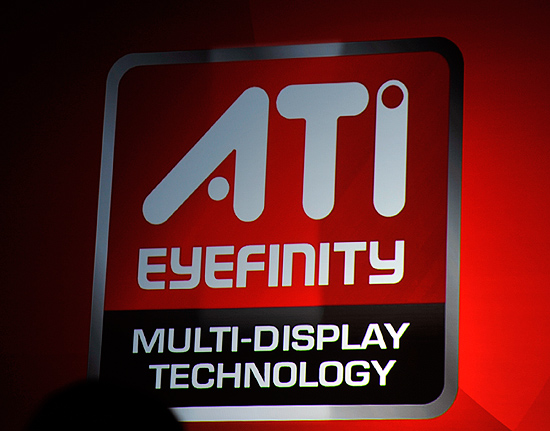
At the bare minimum, the lowest end AMD DX11 GPU can support up to 3 displays. At the high end? A single GPU will be able to drive up to 6 displays.

AMD's software makes the displays appear as one. This will work in Vista, Windows 7 as well as Linux.
The software layer makes it all seamless. The displays appear independent until you turn on SLS mode (Single Large Surface). When on, they'll appear to Windows and its applications as one large, high resolution display. There's no multimonitor mess to deal with, it just works. This is the way to do multi-monitor, both for work and games.
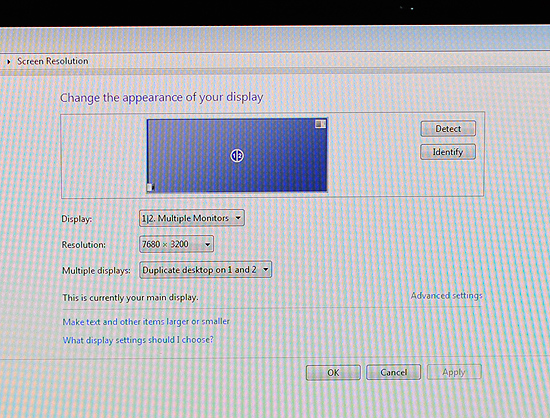
Note the desktop resolution of the 3x2 display setup
I played Dirt 2, a DX11 title at 7680 x 3200 and saw definitely playable frame rates. I played Left 4 Dead and the experience was much better. Obviously this new GPU is powerful, although I wouldn't expect it to run everything at super high frame rates at 7680 x 3200.
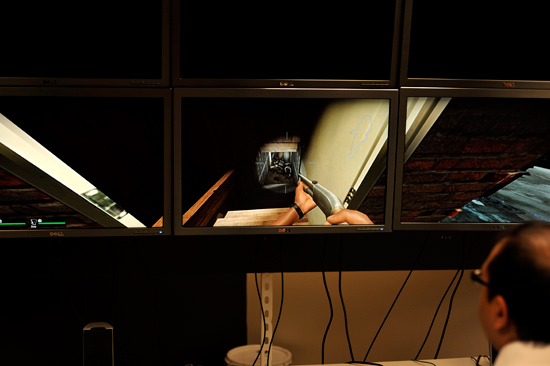
Left 4 Dead in a 3 monitor configuration, 7680 x 1600
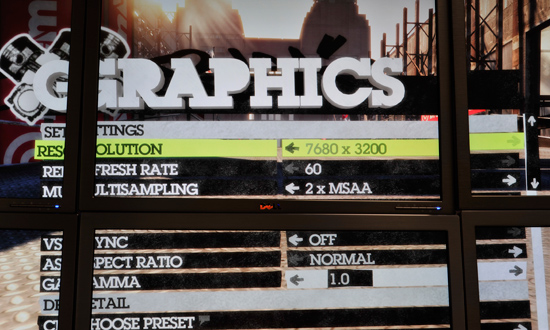
If a game pulls its resolution list from Windows, it'll work perfectly with Eyefinity.
With six 30" panels you're looking at several thousand dollars worth of displays. That was never the ultimate intention of Eyefinity, despite its overwhelming sweetness. Instead the idea was to provide gamers (and others in need of a single, high resolution display) the ability to piece together a display that offered more resolution and was more immersive than anything on the market today. The idea isn't to pick up six 30" displays but perhaps add a third 20" panel to your existing setup, or buy five $150 displays to build the ultimate gaming setup. Even using 1680 x 1050 displays in a 5x1 arrangement (ideal for first person shooters apparently, since you get a nice wrap around effect) still nets you a 8400 x 1050 display. If you want more vertical real estate, switch over to a 3x2 setup and then you're at 5040 x 2100. That's more resolution for less than most high end 30" panels.
![]()
Any configuration is supported, you can even group displays together. So you could turn a set of six displays into a group of 4 and a group of 2.
It all just seems to work, which is arguably the most impressive part of it all. AMD has partnered up with at least one display manufacturer to sell displays with thinner bezels and without distracting LEDs on the front:
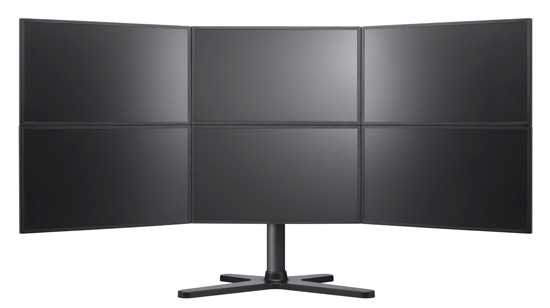
A render of what the Samsung Eyefinity optimized displays will look like
We can expect brackets and support from more monitor makers in the future. Building a wall of displays isn't exactly easy.
The First Generation Holodeck by 2016
When AMD first told me about the RV770 they told me another interesting story. For the past several years AMD (and ATI before it) has been obsessed with trying to figure out when it would be possible to render an image so convincing that it was indistinguishable (at least mostly) from reality.
Given the right art and a good technique to render the scene, this is totally possible not only within our lifetimes but within the next decade. Unfortunately, that's not enough.
Carrell estimates that the human eye can directly resolve around 7 million pixels, almost twice the resolution of a 30" display. But that's just what it's directly focusing on, all of the peripherial vision brings the total up to around 100 million pixels. The Eyefinity demo I showed earlier was running at 24.5 million pixels on a single GPU; you can estimate that at this generation we'll be able to do about 50 million pixels with two GPUs and one more generation from now we'll get to that 100 million pixel marker. That's two years for a single GPU. Then give it a few more years to be able to render that many pixels but with enough complexity to actually look real.
Rendering something at the max resolution that the human eye can resolve isn't enough however; you have to feel immersed in the graphics. That's where Eyefinity comes in, at least what it starts to come in.
Carrell believes that in seven years we can have the first generation Holodeck up and running. For those of you who aren't familiar with the Trek reference, Carrell believes it'll take seven years to be able to deliver a 180 degree hemispherical display (you're not completely surrounded by displays but at least your forward and peripheral vision is) with positionally accurate and phase accurate sound (both calculated by the GPU in real time). The GPU will also be used to recognize speech, track gestures and track eye movement/position.
It doesn't solve the issue of not being able to walk forward indefinitely, but again this is only the first generation Holodeck.
Eyefinity isn't anywhere close, but if you understand the direction: it's a start.

We're at six 2560 x 1600 displays today, is it too far fetched to imagine a totally immersive display setup that renders at life-like resolutions?
First person shooters pretty much dictate that you'll need an odd number of displays to avoid your crosshairs spanning multiple monitors. With three displays you can begin to get the immersion effect, but buy five and you'll be completely surrounded by your game. And as I mentioned before, it doesn't require any special application or OS support, the drivers take care of everything: it just appears as a single, large, surface.
It seems trivial but honestly we haven't had the ability to easily support the ridiculous display setups we always see in sci-fi movies. Eyefinity at least makes it look like we can build the PCs from the Matrix.
Will it succeed? Who knows. Does it sound gimmicky? Sure. Is it cool? Yeah, I'd say so.
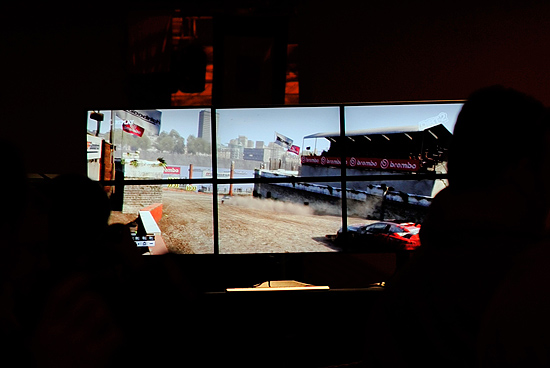
If panel prices could drop significantly enough where putting together an Eyefinity display setup didn't cost more than the graphics card, I think it'd be a much easier sell. Obviously AMD's next-generation GPU is more than just Eyefinity, but you'll hear about the rest late this month.







